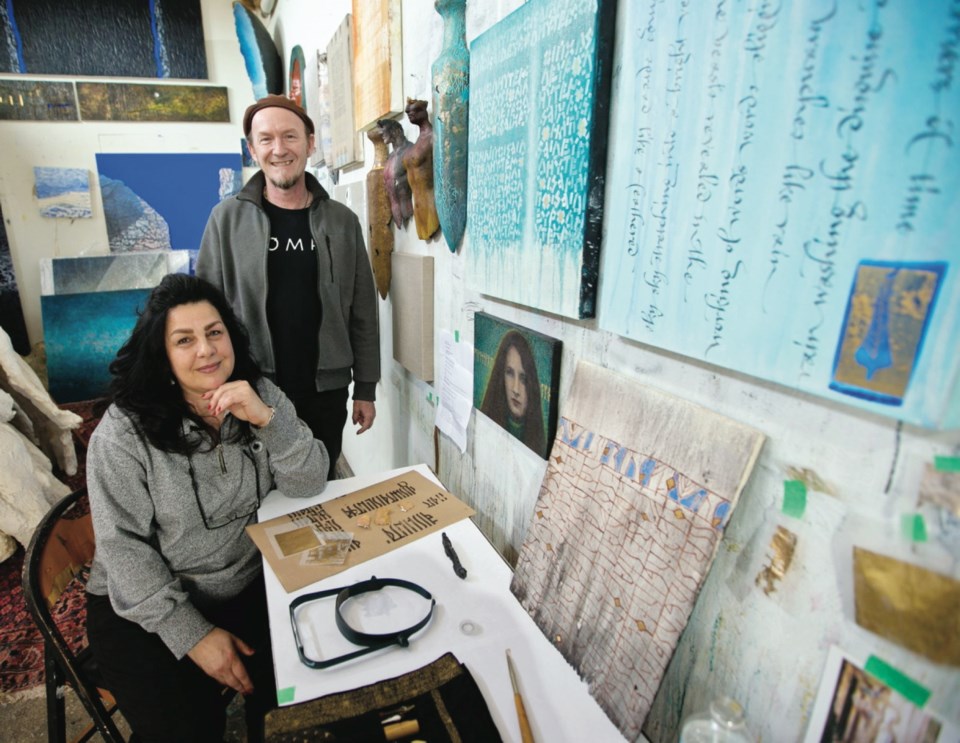Calligrapher Georgia Angelopoulos and painter Miles Lowry met me at Lowry’s garden studio in Fairfield. There, with music, tea and his gregarious pussycat, we looked over 20 pieces they have created together for a show at Eclectic Gallery.
Miles and Georgia go back to age 14. In junior high school, they were students of Waine Ryzak, and at Vic High they came under the influence of an inspiring art teacher, Michael Hemming. Hemming trained in England where he was taught calligraphy by a student of Edward Johnston, the father of modern calligraphy.
“Quite early on,” Angelopoulos told me, “Michael Hemming selected a few of us who showed an aptitude, and set us up in a separate room to focus on calligraphy. That’s where I started to develop an interest in art history.”
She got married, had a family and went on with other things, but later she decided to take up the pen again.
“My area of interest was Byzantine manuscripts and iconography,” she told me. “It’s my Greek background. My family was involved in the arts in Greece. My uncle even took off with some artists to Mount Athos [the famous monastery] and painted for a year. It’s in the blood.”
So she wrote Miles a letter. “We got together and said: ‘Let’s do this.’ We each had texts we loved: me Greek, he Celtic. Together we found commonalities and set to work creatively to explore the readability — or not — of these scripts.”
On one panel she has repeatedly written the word “dream” in Greek. “I did it with a brush in a sort of Asian fashion. There are echoes of what’s going on culturally here, and I can put my hand on that pulse through script.”
The forms she used on another piece are derived from ancient Swedish rune stones, though they are written in English. “A well spring flowing,” it says. It is written on an old piece of wood, the words coloured with lapis lazuli and gold leaf.
“It’s a combination of many things,” Angelopoulos remarks, “and it goes somewhere else.”
With her formal training, she undertakes commissions to produce traditional documents that look very British, in the italic hand. She has just completed a “freedom scroll” for Saanich Mayor Frank Leonard. Yet she’s more concerned with the spiritual ideas behind lettering, which she thinks have been lost. Regarding the powerful connection between each of us and our own handwritten marks, she recommended a book, The Golden Thread by Ewan Clayton.
The origin of writing is often explained as a necessity for commerce. The Phoenicians, a trading nation, gave us our alphabet. But some writing originated in divination, for the purpose of interpreting spiritual ideas. The early Chinese language was first engraved on “oracle bones” used in divination.
In the Western world, we can look to the miraculous illuminated gospels produced in scriptoria at Kells and Lindisfarne on the northern edge of the British realm. Angelopoulos laments that so much philosophy and sanctity about writing have been lost.
Some of the new panels at Eclectic Gallery carry quotations from the Greek lyric poetess, Sappho, whose words invoke the Muses, uttering their names like a prayer. After many patient hours at her desk, Angelopoulos says writing them conveys an unmistakable sense of praying with the pen. With modern technology much has been lost.
“Yet the marks we make are always changing,” the calligrapher noted. Altering and adjusting the written forms of words is her way of examining and thinking about things. In this way, she draws people’s attention to the beauty of letters and their traditions.
Lowry is creating the supports for the artworks: small cradled wooden panels, his signature cast paper torsos and wall-mounted shapes like ancient vases. There is even a model of the altar stone of New Grange in Ireland, for which Angelopoulos created a modern version of Ogham script as seen on Irish and Pictish stone monuments. She brought papyrus from Egypt, and Lowry created a painted version.
Basically a realist painter with a mystical bent, Lowry this time created essentially non-objective paintings to write on. In one case, Angelopoulos inscribed a few words from Sappho in balanced blocky letters. The lettering is very crisp and precise … and then dissolves and runs off the bottom of the canvas.
“That would be Miles,” Angelopoulos laughed. He lets her go just so far with the neatness and then steps in with his loaded brush.
Lowry created some paintings with figures in them and then said to her: “I need some characters here.” So she got to work with texts chosen from Greek, Irish, Gaelic and Medieval worlds. Lowry himself is a published poet.
Each tends to have pieces of text that resonate.
“We’ll share these little snippets,” Lowry said, “and when we both get the kind of ‘Yes!’ feeling, we are ready to go forward. Usually, I make marks first, building up a surface, going for a feeling which is elemental. Georgia will start designing the writing. She makes some marks and then says “do your thing.” I disintegrate them, then she’ll go back at them. We’ve kind of been passing them back and forth ….
“Eventually we’re both in there, right on top of each other. We haven’t yet got to the point of working on the same canvas at the same time, but we’re going to get there.”
In the end, the marks on the page are more important to them than the legibility of the texts.
“It doesn’t matter as much if people read them,” Angelopoulos concluded, “as that they feel the way we felt about them.” You’ll get the message.
Marks of Devotion, collaborative works by Georgia Angelopoulos and Miles Lowry, April 7 to May 10 at Eclectic Gallery, 2170 Oak Bay Ave., 250-590-8095 and eclecticgallery@shaw.ca
